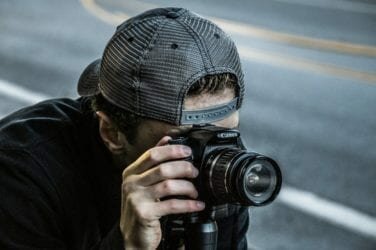A mistake many film school students make is they want to write the most absurd stories with explosions and action, and guns in space, and time travel to an aquarium in the future where all the fish do what you say …
Ambition is great to have, but when you have limited experience and almost no money sometimes you have to get clever when you actually attempt to film your first short film, or second and 22nd.
When writing a story, you’ve probably heard the term ‘Show Don’t Tell’, but have you ever heard the term ‘Elude, Don’t Show’? If you haven’t then it’s probably because I made it up (unless someone else somewhere already said it and I just didn’t know).
After being a part of many short films myself, both in front of and behind the camera, I’ve found a common mistake film students make – they feel the need to actually show the entire scene in detail because otherwise the audience won’t get it – and they fail because it turned out to be too complicated or the cops showed up and shut it down.
However, there are many ways you can get the desired effect of the scene without actually showing anything.
For example: Car crashes. No film student has the budget or the knowledge to literally crash a car over and over again with all the actors inside and come out at the end of the day without anyone getting hurt or killed.
There are multiple ways of doing this, you just need to learn how to go about it with more of the smarts and less of the … not smarts…? You gotta allude to the crash, basically by filming reactions, showing everything happening up until the actual crash, and even using sound design in post.
Another example: Getting hit by a car.
I’ve been a script advisor on a student short film where the main character gets hit by a car. Many times I mentioned they didn’t actually need to show the actor getting hit, and they can film her on her phone, about to cross the street but then the camera stops right beforehand and films the red crossing man as we hear the sound of tires screeching.
That was just an example of what they could have done.
However, they insisted on actually showing the actor walk out onto the road multiple times and ‘fall’ onto a large pillow as random cars pulled up to the traffic lights. Yes, I said ‘random’ cars. Which as you could imagine, the drivers in those cars are wondering what the heck is going on.
Then the cops showed up and the set was almost shut down. Awkward.
If you really think about it, you would have seen countless A list films that even use these types of techniques. They don’t show everything and because of that the rest is left up to our imagination, which is just as powerful!
Showing the crazy, intense, and unnecessary expensive scenes isn’t always needed when you can move the audience to use their imagination.
All you need to do is get crafty and resourceful with what you have because a great story can be simple and a great movie can be simply made.
It’s possible for a first (or second) short film to be creative and compelling. My wish is for film school students to grasp these ideas and run with them.

















